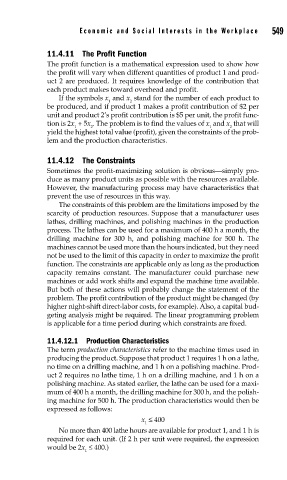Page 596 - Sensors and Control Systems in Manufacturing
P. 596
Economic and Social Inter ests in the Workplace
11.4.11 The Profit Function 549
The profit function is a mathematical expression used to show how
the profit will vary when different quantities of product 1 and prod-
uct 2 are produced. It requires knowledge of the contribution that
each product makes toward overhead and profit.
If the symbols x and x stand for the number of each product to
1 2
be produced, and if product 1 makes a profit contribution of $2 per
unit and product 2’s profit contribution is $5 per unit, the profit func-
tion is 2x + 5x . The problem is to find the values of x and x that will
1 2 1 2
yield the highest total value (profit), given the constraints of the prob-
lem and the production characteristics.
11.4.12 The Constraints
Sometimes the profit-maximizing solution is obvious—simply pro-
duce as many product units as possible with the resources available.
However, the manufacturing process may have characteristics that
prevent the use of resources in this way.
The constraints of this problem are the limitations imposed by the
scarcity of production resources. Suppose that a manufacturer uses
lathes, drilling machines, and polishing machines in the production
process. The lathes can be used for a maximum of 400 h a month, the
drilling machine for 300 h, and polishing machine for 500 h. The
machines cannot be used more than the hours indicated, but they need
not be used to the limit of this capacity in order to maximize the profit
function. The constraints are applicable only as long as the production
capacity remains constant. The manufacturer could purchase new
machines or add work shifts and expand the machine time available.
But both of these actions will probably change the statement of the
problem. The profit contribution of the product might be changed (by
higher night-shift direct-labor costs, for example). Also, a capital bud-
geting analysis might be required. The linear programming problem
is applicable for a time period during which constraints are fixed.
11.4.12.1 Production Characteristics
The term production characteristics refer to the machine times used in
producing the product. Suppose that product 1 requires 1 h on a lathe,
no time on a drilling machine, and 1 h on a polishing machine. Prod-
uct 2 requires no lathe time, 1 h on a drilling machine, and 1 h on a
polishing machine. As stated earlier, the lathe can be used for a maxi-
mum of 400 h a month, the drilling machine for 300 h, and the polish-
ing machine for 500 h. The production characteristics would then be
expressed as follows:
x ≤ 400
1
No more than 400 lathe hours are available for product 1, and 1 h is
required for each unit. (If 2 h per unit were required, the expression
would be 2x ≤ 400.)
1

